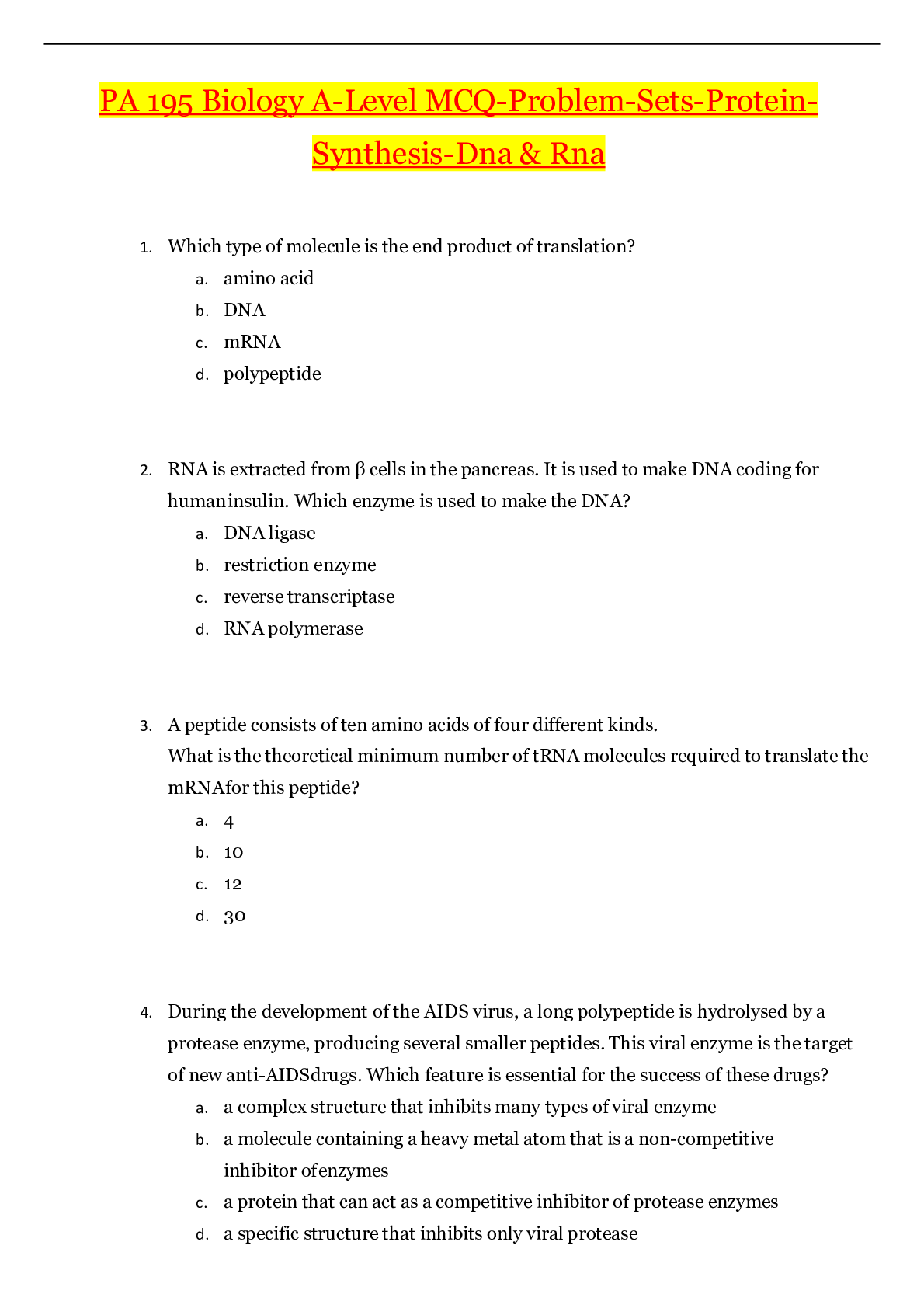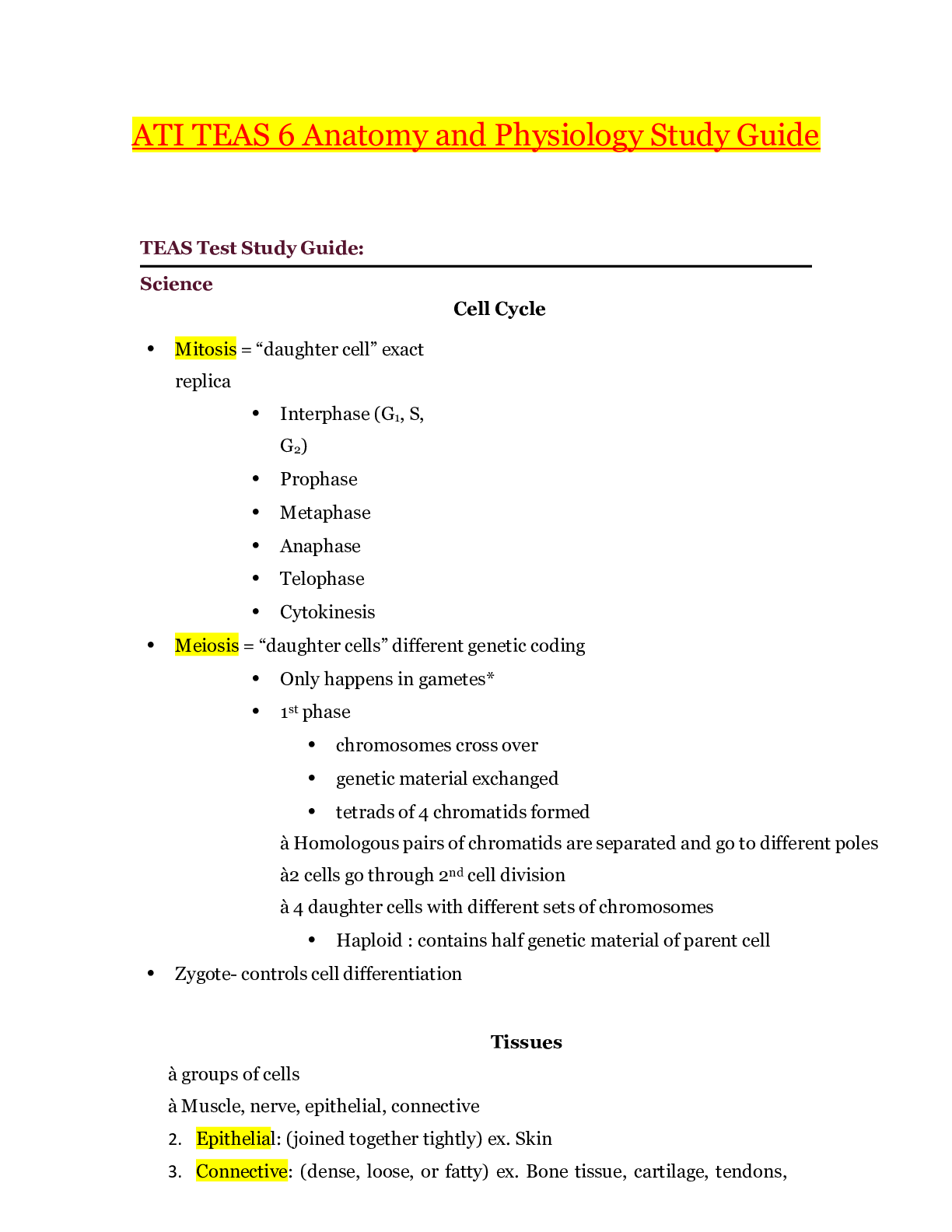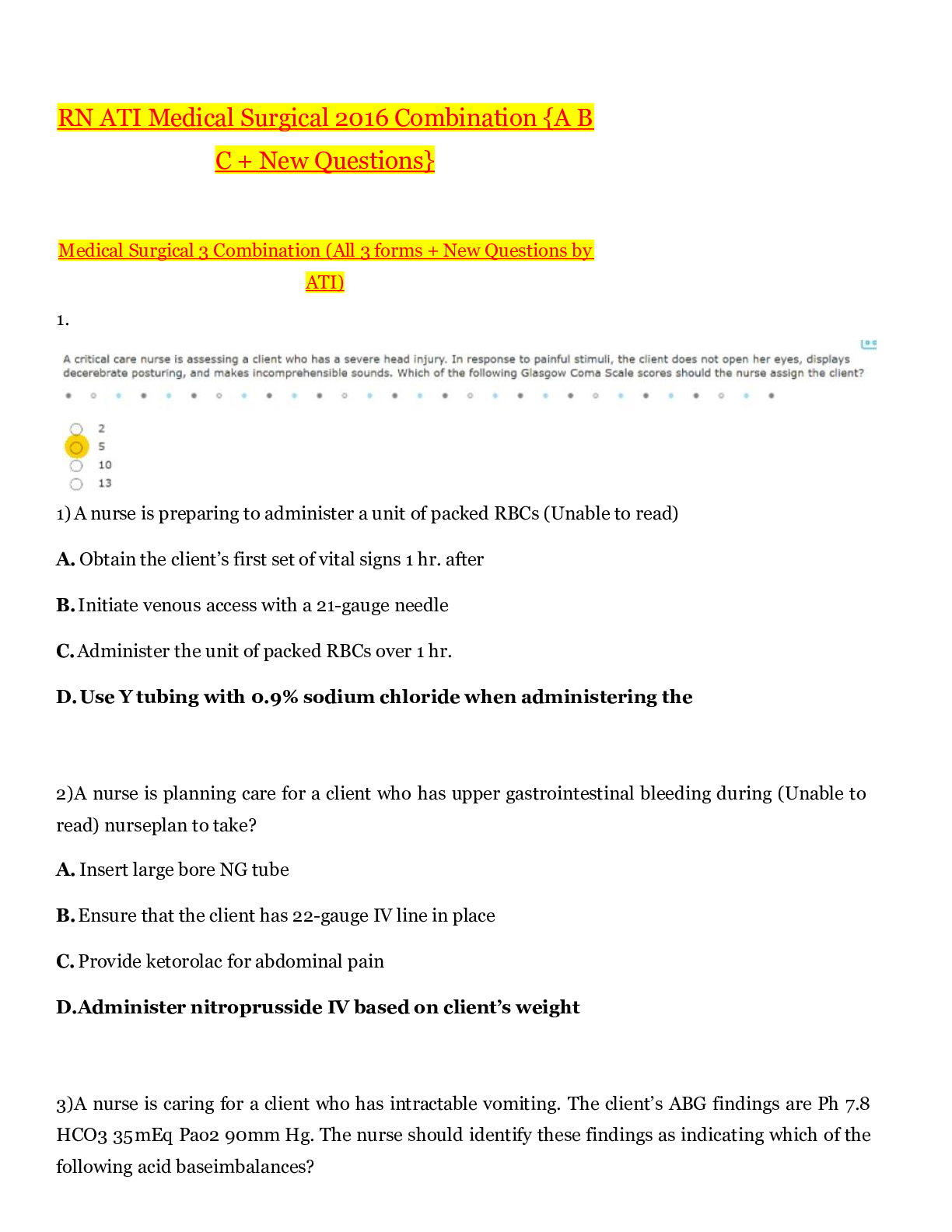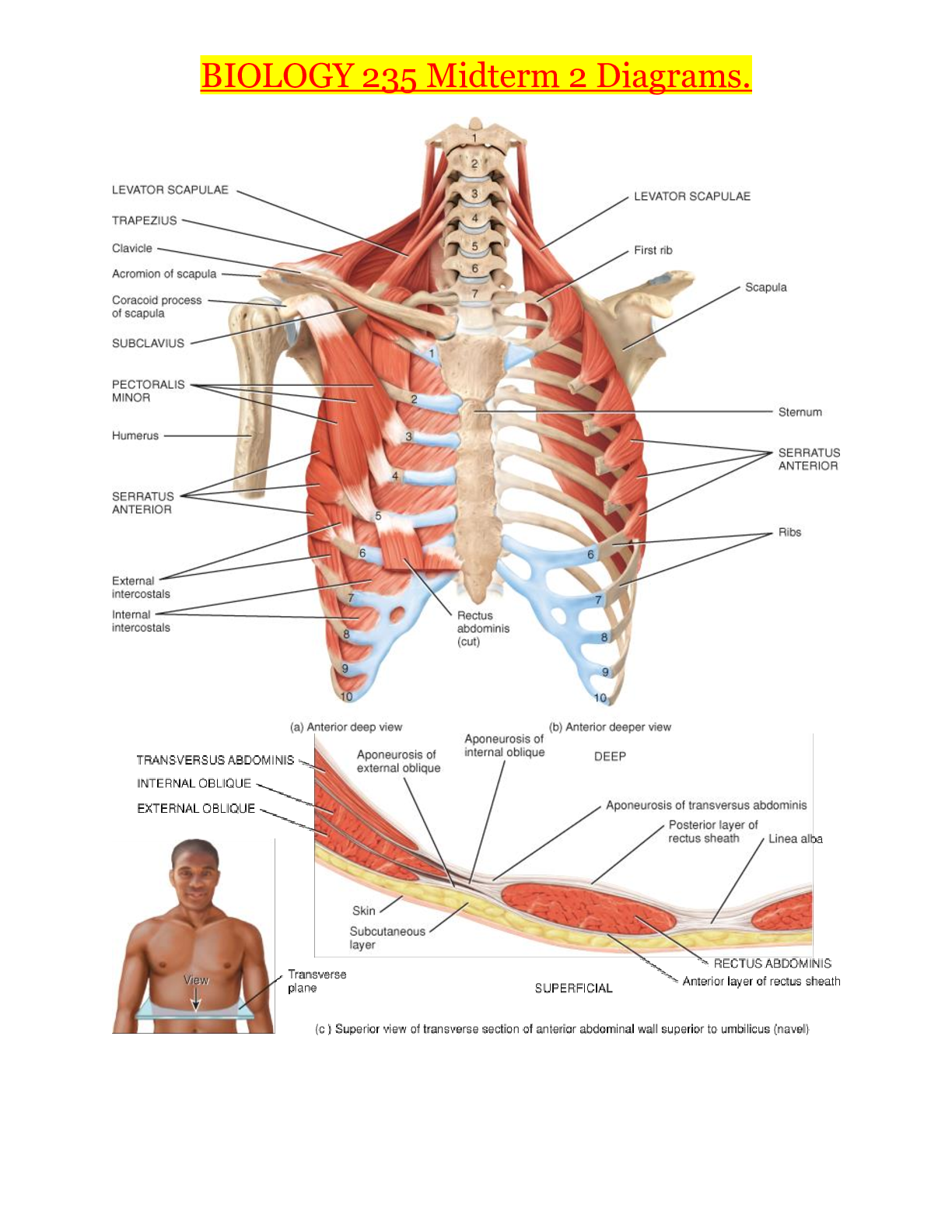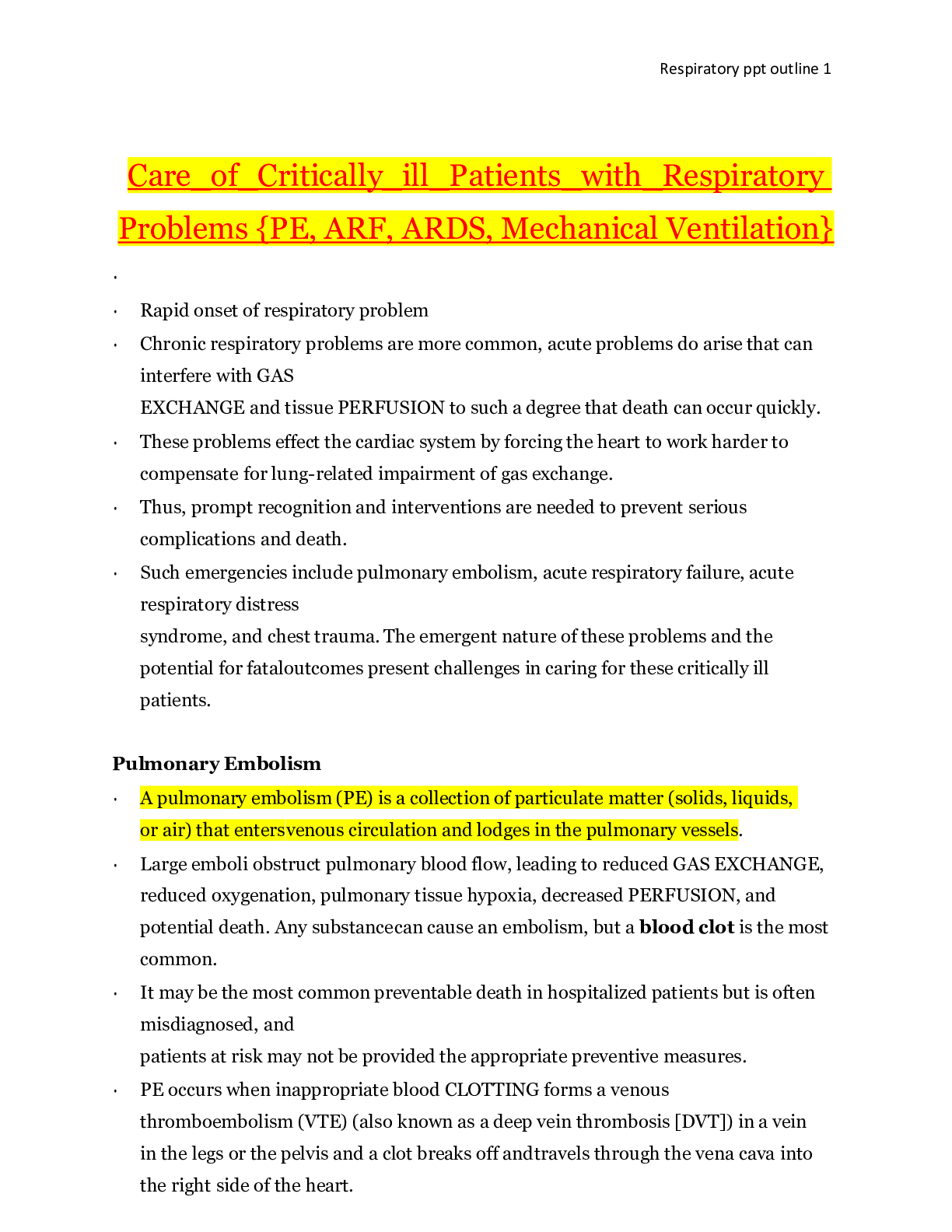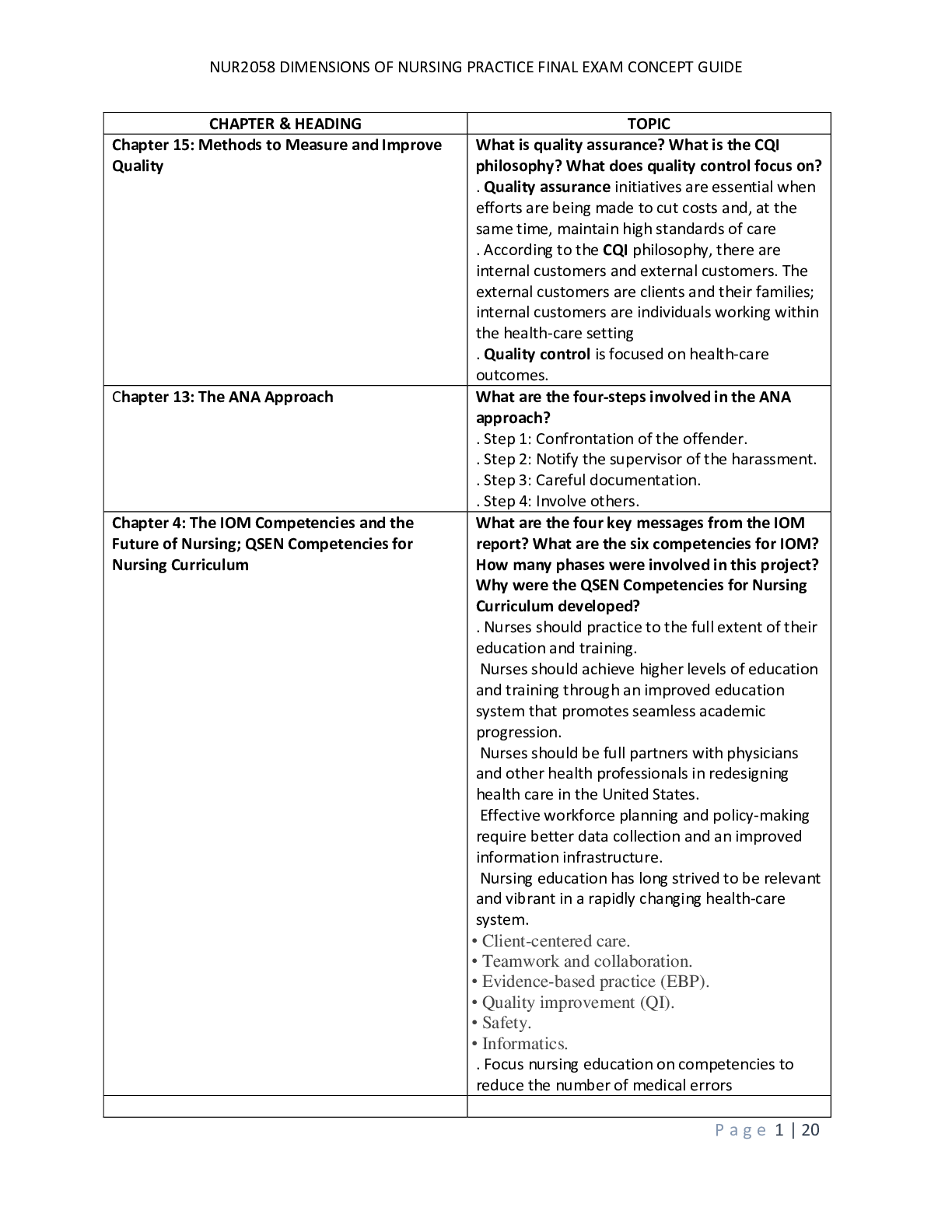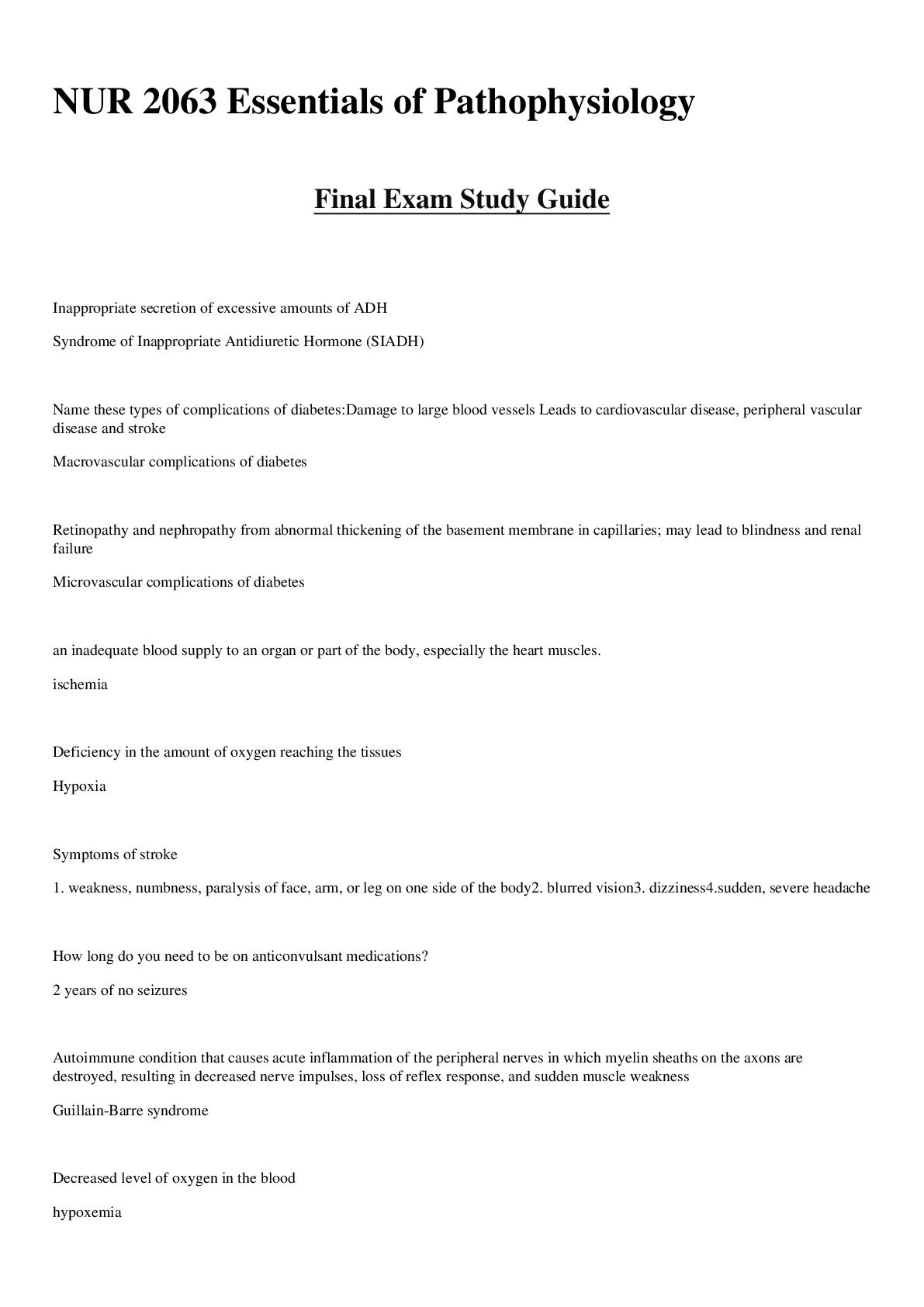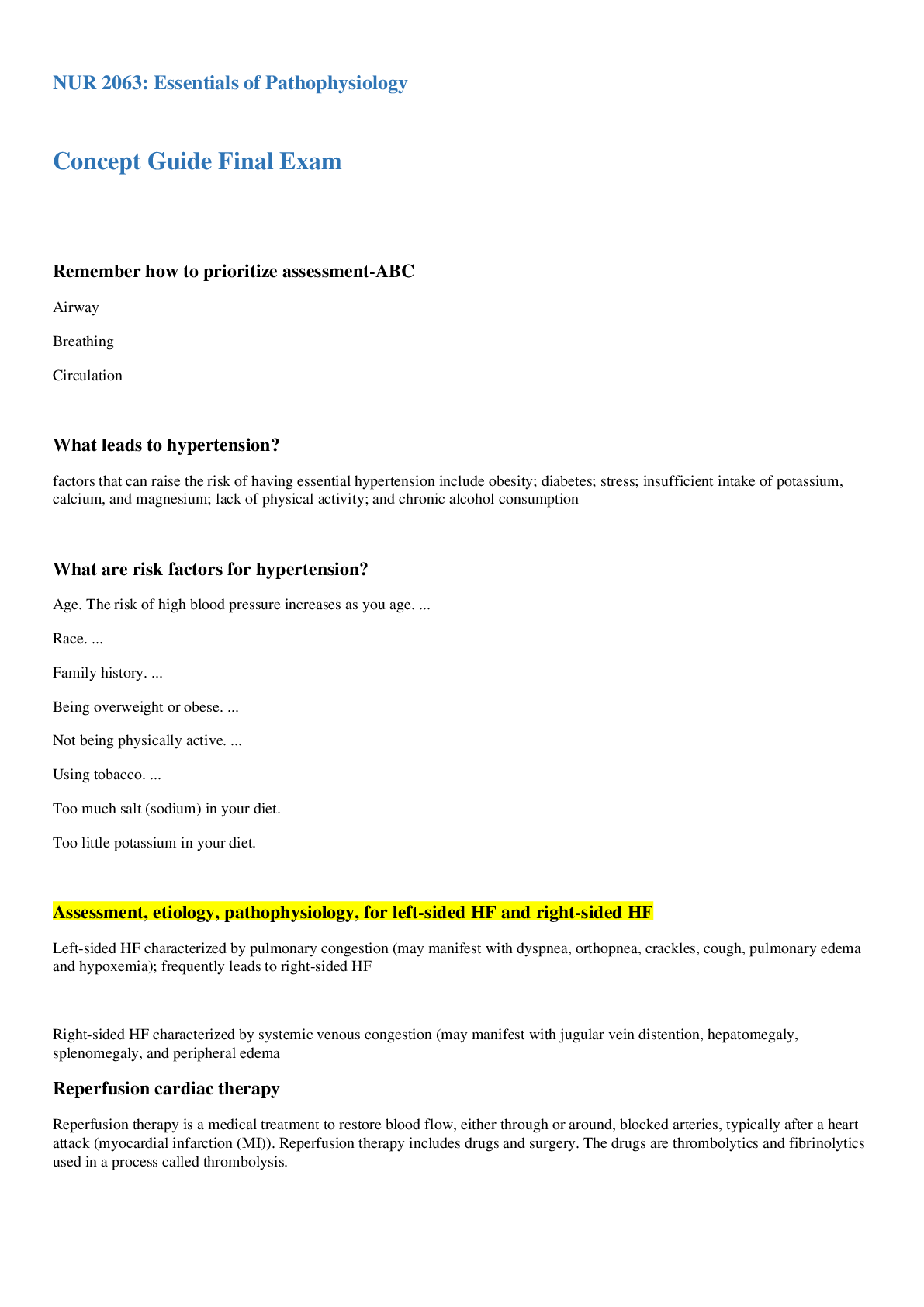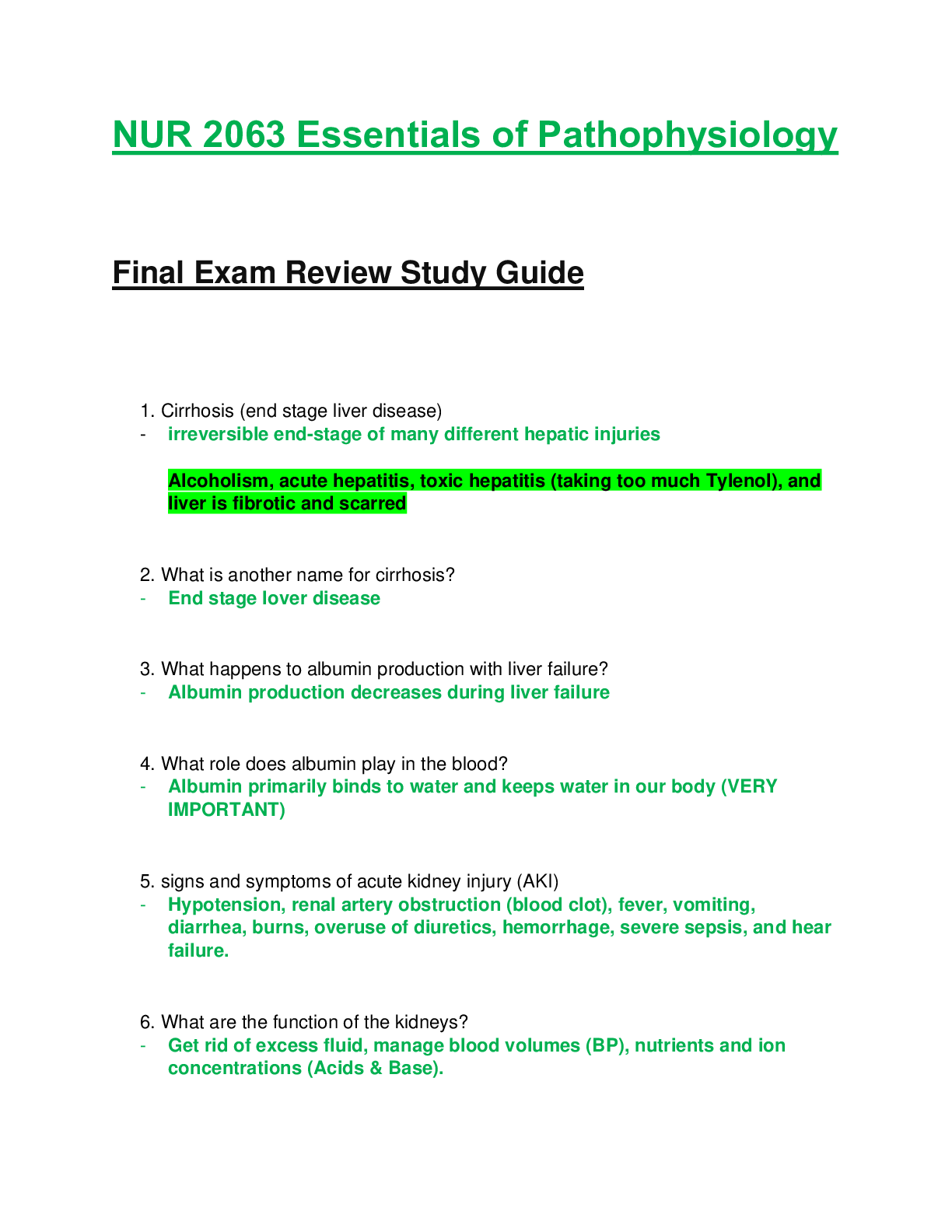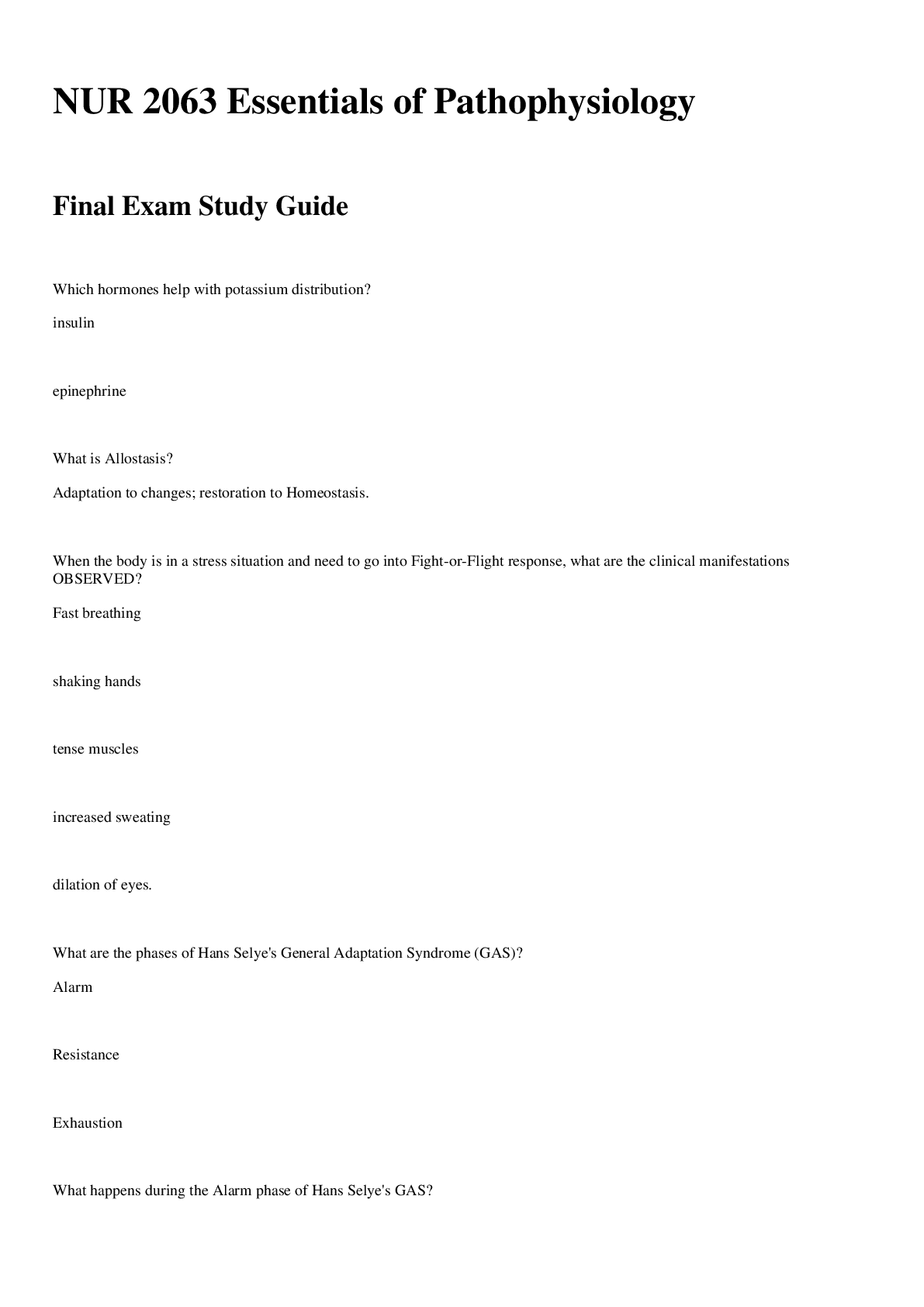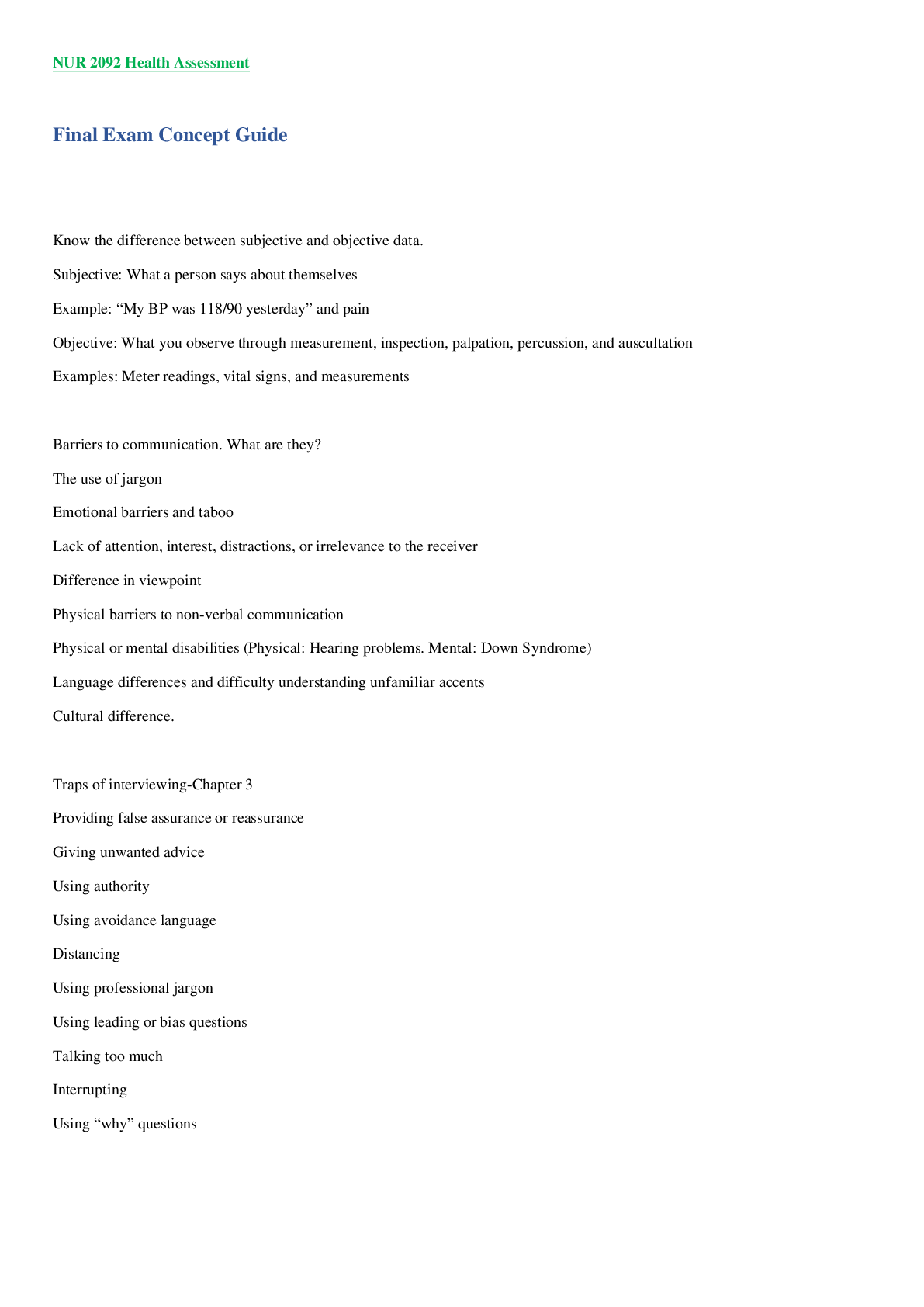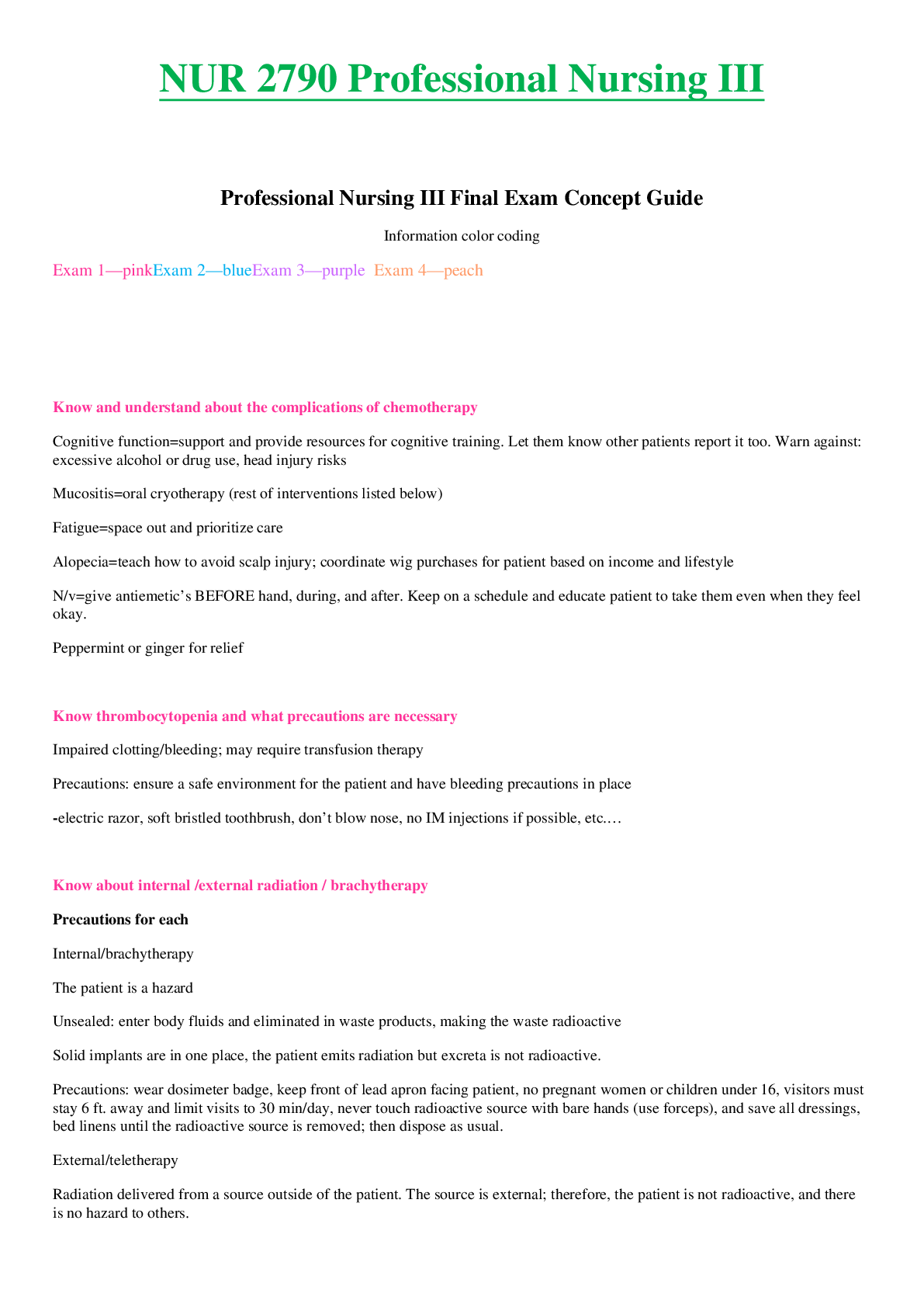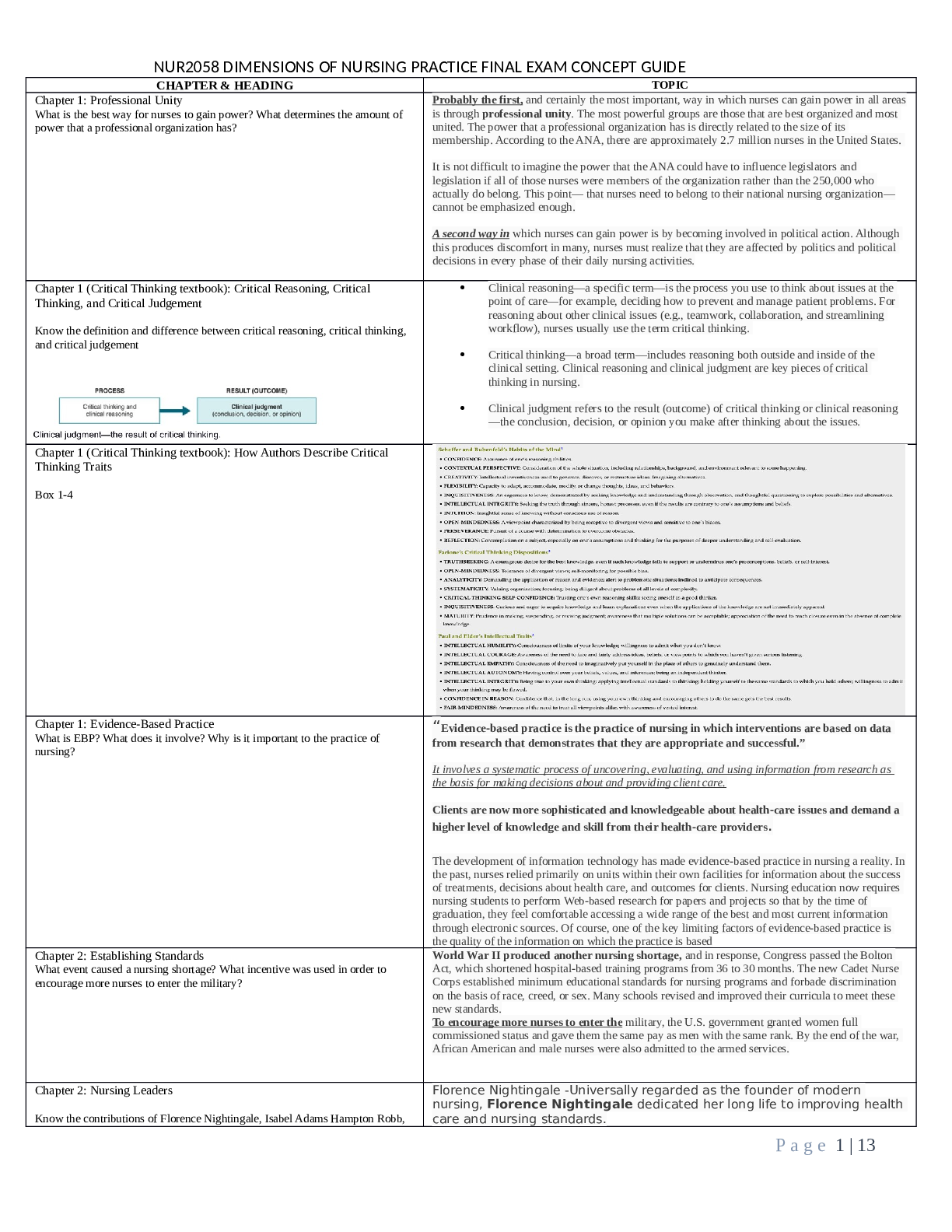Pathophysiology > STUDY GUIDE > NUR 2063 Pathophysiology Final Exam Spring 2020 | NUR2063 Pathophysiology Final Exam Concept Guide (All)
NUR 2063 Pathophysiology Final Exam Spring 2020 | NUR2063 Pathophysiology Final Exam Concept Guide
Document Content and Description Below
NUR 2063 Pathophysiology Final Exam Study Guide {REVISED} Spring 2020 Final Exam Concept Guide Know the Etiology, Signs/Symptoms, Diagnosis/Diagnostics, Clinical Manifestation, Risks, Treatment ... and Complications for the following: Gastritis Gastritis – inflammation of the stomach lining Acute Gastritis – (just acquired) ingestion of toxins, alcohol, aspirin or other irritating substances Chronic- 2 months to become chronic Triggers of Gastritis: Alcohol, caffeine, autoimmune disease, viral or bacteria Chronic Gastritis: H Pylori is always a factor H Pylori goes very deep in the lining of the stomach and It causes persistent inflammation S/S: N/V – Anorexia- postcranial discomfort Post Cranial Discomfort- after eating- goes away and come back 1-2 hrs Gastritis- hematemesis- blood in the vomit- coffee brown color Treatment: Treat H pylori treat GERD, change lifestyle, PPI Peptic Ulcer Disease Inflammation and ulceration in the stomach (acid and pepsin) Gastric: stomach location Duodenal: duodenal location PUD is a complication of Gastritis PUD is caused by aspirin, H pylori, Nsaids, Stress, Smoking S/S Gastric N/V Anorexia Chest discomfort, asymptotic, Dyspepsia Duodenal – normal weight Biggest complication of PUD- GI bleeding due to Ulcer perforation- hole in the lining and bleed It is life-threatening if it keep bleeding (Anemic, electrolytes imbalance (losing volume) Duodenal – Blood in the stool – black and tarry Bleeding profusely-frank with cloth Hematemesis- Bleeding in vomiting Treatment: Cortery of perforation, treatment of H. pylori, PPI, Cessation of smoking Ulcerative Colitis and Crohn’s the difference in the complications Complication in UC Malnutrition – dehydration, increased risk factor of colon cancer 7-10 yrs, rarely in megacolon Complication of Chron- Fistulas, perianal fissures, abscesses. The risk of colorectal cancer Bowel Obstruction Manifestations Obstructions in the jejunal area: Vomiting, dehydration, electrolyte depletion Obstructions of the distal portion of the small bowl or ileum, dehydration to hypovolemic schock Obstructions of the colon: Massive gas distention Blockage of the colon by a tumor is the most common cause of colonic obstruction and perforation of the bowel wall adjacent to the tumor. What percentage of the pancreas is dedicated to endocrine functions? Only 5% Pancreatic Cancer Pancreatic Cancer – 2% of all cancers Ranked 4th among death in all malignancies Risk Factors; cigarette smoking, obesity S/S; head: Jaundice, malabsorption, weight loss tail: Abd pain, nausea’ Hepatic Encephalopathy is due to? Hepatic encephalopathy is a decline in brain function due to severe liver disease Hepatic encephalopathy is usually precipitated by certain well-defined clinical developments, including hypokalemia, hyponatremia, alkalosis, hypoxia, hypercarbia, infection, use of sedatives, GI hemorrhage, protein meal gorging, renal failure, and constipation. In some patients, progressive liver failure leads to chronic encephalopathy without other exacerbating factors. Hepatic encephalopathy is graded 1 to 4: • Grade 1: Confusion, subtle behavioral changes, no flap • Grade 2: Drowsy, clear behavioral changes, flap present • Grade 3: Stuporous but can follow commands, marked confusion, slurred speech, flap present • Grade 4: Coma, no flap Gastroesophageal Varices Management - Initial treatment: Fluid resuscitation to stop bleeding - Large bore intravenous lines are placed - Admin of parenteral vitamin K and plasma, platelet infusion if thrombocytopenia is present - Octreotide acetate (synthetic analog) no more vasopressin 3-5 days - Metoclopramide and B blockers - Esophagogastroduodenoscopy EGD to determine site of bleeding Difference between Diverticulosis and Diverticulitis Diverticulosis (diverticular disease) presence of diverticula in the colon. Diverticula are acquired herniations of the mucosa and submucosa through the muscular coat of the colon Diverticulosis The presence of one or more diverticula vs diverticulitis inflammation of one or more diverticula Kidney Disease- Assessment-CVA Pain associated with intrarenal disorders are assessed by palpating or light percussion over the costovertebral angle (CVA) posteriorly and is recorded as CVA tenderness. Pain is transmitted to the spinal cord between T10 and L1 Kidney Cancer signs and symptoms Benign renal neoplasm: S/S Hematuria and flank pain Some may be asymptomatic until large Renal cell carcinoma: Metastatic disease Risk factors: smoking, obesity and hypertension S/S CVA tenderness, hematuria, palpable mass Dialysis- Benefits and Risks Filter blood and rid the waist Dialysis is the only therapeutic option for those with ESRD unable to obtain transplant Each treatment of dialysis remove about 2/3 of the total body urea content Dialysis maintain volume status Prevent and treat acid-base and electrolyte disturbances Prevent and treat uremia Support nutritional needs. Prevent and treat infection Orevent and treat anemia Improve quality of life Lower mortalty and morbidity rates Control pains VS RISKS Electrolytes imbalance (potassium and sodium) -need to check hyper or hypo Low blood pressure (have to check vitals before and after) Risk for infection Long-term mobidity Life threatening Cardiovascular disease remained the most common cause of death in ESRD patient Acute Kidney Injury- Three phases- Prodromal- Oliguric- Postoliguric Prodomal Phase - Normal or declining urine output - Serum blood urea nitrogen (BUN) and creatine levels rise Oliguric phase (10-14 days) range from 1 day to 8 weeks - Oliguria – Small abnormal amount of urine - Edema, Hypertension, Hypervolemia - Distended neck veins, weight gain - Crackles, possibly heart faily - WBC and RBC in urine - Protein in urine - Hyperkalemka - Volume overload - Azotemia and uremia - Metabolic acidosis Postoliguric phase (5% recover) - Fluid volume deficit - Labs begin to normalize - Polyuria – sodium waste Acute Tubular Necrosis and the causes of Acute Tubular Necrosis ATN is the result of tubular cell injury - Ischemia: Exposure to nephrotoxic substances - ½ of all cases of AKI Nephrotoxins leading cause of ATN (aminoaglycosides, NSAIDS, amphotericin B, cisplatin, tetracycline. CI- AKI or Contrast-induced nephropathy Cystitis- signs and symptoms (inflammation of the bladder) no fever or flank pain If fever is present – Might be infection (UTI) Confusion Cloudy urine Frequency Urgency Dysuria Intrarenal Kidney Injury- Toxic causes of Box 28.1 Types of Acute Kidney Injury Prerenal • • Absolute decrease in circulating volume o • Hemorrhage o • Dehydration o • Burns • • Relative decrease in circulating volume o • Distributive shock (neurogenic, anaphylactic, septic) o • Third-spacing and edema o • Decreased cardiac output • Cardiogenic shock • Dysrhythmias • Cardiac tamponade • Heart failure • Myocardial infarction • • Primary renal hemodynamic abnormalities o • Occlusion or stenosis of renal artery* o • Drug-induced impairment of renal autoregulation in susceptible persons† Postrenal • • Benign prostatic hyperplasia • • Kinked or obstructed catheters • • Intraabdominal tumors • • Strictures • • Calculi Intrarenal/Intrinsic • • Tubular (acute tubular necrosis) o • Ischemic • Prolonged prerenal failure • Transfusion reactions • Rhabdomyolysis o • Nephrotoxic • Prolonged postrenal failure • Certain antimicrobials (antibiotics; antifungal and antiviral drugs) • Radiographic contrast media • Certain cytotoxic chemotherapy agents • Recreational drugs (amphetamines, heroin) • Environmental agents (heavy metals, carbon tetrachloride, insecticides) • Snake and insect venom • • Glomerular o • Acute glomerulonephritis • • Interstitial o • Acute allergic interstitial nephritis o • Acute pyelonephritis • • Vascular o • Vasculitis o • Emboli o • Nephrosclerosis (due to primary hypertension, hypertensive emergencies, and urgency) Two electrolytes that are affected by the kidney’s inability to regulate. Potassium and Sodium Hypokalemia and Hyponatremia Renin-Angiotensin-Aldosterone System and the relationship between the autoregulation of the kidneys Renin-Angiotensin-Aldosterone System (RAAS) act to increase the total circulating volume in the kidney attempt to autoregulate perfusion and maintain GFR. What is the Glomerelus? It is a segment of nephron that filters fluid from blood into Bowman capsule, prevents passage of blood cells and proteins. What is Glomerulonephritis? An assortment of immune-mediated conditions that produce inflammation of the glomeruli. Diabetes Type I and Type II Type 1: Destruction of the B cells of the pancreas results in absolute insulin deficiency 5-20 yrs Chromosone 6 Type 2: Most common form of DM – Insulin resistance and B cells dysfunction lead to a resistance lack of insulin Risk factor: Female sex, obesity, and sedentary lifestyle Risk factor: non Caucasian, elderly Poly’s of Diabetes 3 P : Polyuria, Polyphagia, Polydipsia Cushing’s Syndrome characterized by Cushing Syndrome Adrenocortical Insufficiency Truncal obesity Moon face Dorsocervical fat pad Hirsutism Muscle wasting Striae Petechiae Glucose intolerance Hypertension Hypokalemia Weakness Hypotension Hypoglycemia Hyperpigmentation (Addison disease) Hyperkalemia Weight loss Traumatic Brain Injury Traumatic brain injury (TBI) refers to injuries of brain tissues sustained as a consequence of trauma Traumatic brain injury == head injury Injuries to the cranials ≠ not always brain injury TBI is the leading cause of death and disability in the U.S. 50,000 + yr Causes TBI (falls, sports injuries, firearms, and transportation-related trauma) Fall majority for 0-4 or 65+, motor vehicle TBI – 14-24 yr. Men are more likely to die than women Types of TBI: Severity Location Mechanisms of injury Severity of TBI is classified by Glasgow coma scale (CGS) (standardized tool developed for the purpose assessing the LOC in acutely brain-injured patients. To evaluate patient with an altered LO Glasgow coma scale: Mild score (13-15), Moderate (9-12), severe (8 – below) Primary injury- initial trauma injury on brain cells - Focal injuries (coup) - Polar injuries (coup contrecoup) - Diffuse injury In addition, as location, Primary Injury can also differentiated by Mechanism of injury - Concussion - Contusion - Intracranial hematoma. Concussion also known as Mild traumatic brain injury (MTBI) most common for military and athletes. Alterations or LOC≤30 mn but no evidence of brain damage on CT. Symptoms: Headache, n/v, dizziness, fatigue, blurred vision, cognitive, emotional disturbances Contusion CT or MRI reveals area of Brain Tissue damage (necrosis, laceration, bruising) Intracranial hematoma: Localized collection of blood within the cranium. Three types; Epidural, subdural, subachnoid. Secondary Injury : Body’s response to initial injury may cause more harm than the initial injury. Can cause: Ischemia, hypoxic events, vasogenic/neurogenic edema, and other processes that leads to brain swelling and increased ICP. Treatment: Cardiopulmonary stabilization. Radiologic screening, maintenance of normal body temperature or mild hypothermia, normal PaCO2, normal glucose level and noema intravascular volume recommended. Acutely elevated ICP, mannitol(osmotic diuretic) sedation, hypothermia and mild hyperventilation. Reperfusion Injury- Definition Reperfusion injury is the secondary injury that occurs after reestablishing blood flow Increased Cranial Pressure- ICP ICP is the pressure exerted by the contents of the cranium and normal ranges from 0-15 mmhg The volume of the cranium nerve is made up 3 parts: brain tissue, cerebrospinal, blood Monroe-kellie hypothesis – the relationship between the 3 components of cranium Compliance – the ability to accommodate changes in volume w/o sign. Increase in pressure The most common causes of ICP: stroke, trauma and tumors Most sensitive indicator of altered brain function? A change in Level of consciousness LOC is one of the most sensitive indicators of altered brain function Assessment of the brainstem function- How do you assess it? Pupil light reflex Oculovestibular reflex Corneal reflex CVA- Types and causes Transient ischemic attack (TIA) – Episodes of stroke s/s with a duration of less than 24 hr and less than1hr (30% pt with stroke have prior TIA) Ischemic stroke- Sudden occlusion of cerebral artery secondary to thrombus formation/embolization - Thrombotic strokes: atherosclerosis and hypercoagulable states - Embolic strokes: cardiac sources Hemorrhagic stroke = Hemorrage within the brain parenchyma and after a severe and long-standing Hypertension. (30 % mortality rate) Test used to diagnosed CVA Non-contrast CT scan /diffusion weighted brain MRI Meningitis what is it? Meningitis is the pyogenic infection that invades the leptomeninges and the subarachnoid space. the most comment sequela to microbial invasion of the CNS. (most bacterial but can be viral/fungal) Bacteria: Streptoccocus pneumoniae Encephalitis What is it? Encephalitis is the inflammation of the brain caused by viruses, bacteria, fungi and parasites Seizures- how they are classified? 1. Generalized seizures: Entire brain Surface • Absence (petit mal) • Atypical absence • Myoclonic • Atonic (drop attack) • Clonic • Tonic • Generalized tonic-clonic (grand mal) 2. Partial Seizure: Part of the brain surface • Simple partial: There is no impairment of consciousness during the seizure. • Complex partial: There is impairment of consciousness during the seizure. • With secondary generalization: Onset begins as simple partial and then progresses to impairment of consciousness. Status Epilepticus what is it? Status Epilepticus is a continuing series of seizures without a period of recovery between episodes Dementia Progressice deterioration and continuing decline of memory and other cognitive changes 60 % to 80 % of Alzheimer are dementia- Vascular dementia is the most common cause No cure Cause is unknown Dementia-causing illness: - Alcoholism - Alcoholism - Intracranial tumor - Normal-pressure hydrocephalus - Parkinson disease - Lewy body disease - Huntington disease - Multiple sclerosis MS - Bocine Spongiform encephalopathy (Mad Cow) Delerium and depression in elederly different than dementia Delirium in global mental dysfunction – Acute Confusional state Primary risk factor: age and family Others: Head trauma, diabetes, depression, stroke, hypertension diabetes Signs and Symptoms memory lost, anxiety and agitation, diffulty in judgement, problem solving and communication. Assistance needed for ADL . Difficulty eating and swallowing. Weight loss Parkinson disease Disorder of mobility - 1 million americans affected. 60,000 cases each year 4 % are younger than 50 Y/O idiopatic or acquired Common causes: Infection, intoxication, and trauma Drug Toxicity: Phenotiazine class: (Chlorpromazine, prochlorperazine, Thioridazine) and Butyrophenone(haloperidol) Parkinson disease results from degeneration of the pigmented dopaminergic neurons found in the subtantia nigra and to a lesser extent neurons elsewhere in the brain. Lewy bodies are cytoplasmic inclusions are found in the surviving neurons. GERD signs and symptoms Heartburn Chest pain Regurgitation Epigastric pain Dry cough Hoarseness in the morning Esapheogeal strictures with Gerd Multiple Sclerosis- Structures effected by the demyelination? Chronic demyelinating disease of the CNS – sign disability in young adults - - - - - - - Continued [Show More]
Last updated: 2 years ago
Preview 1 out of 41 pages

Buy this document to get the full access instantly
Instant Download Access after purchase
Buy NowInstant download
We Accept:

Reviews( 0 )
$14.00
Can't find what you want? Try our AI powered Search
Document information
Connected school, study & course
About the document
Uploaded On
Mar 10, 2021
Number of pages
41
Written in
Additional information
This document has been written for:
Uploaded
Mar 10, 2021
Downloads
0
Views
68




